Chapter 1
Painting in Photoshop
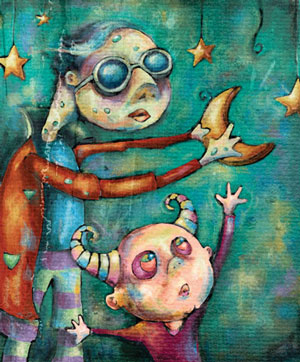
The simulation of natural media is always a tricky prospect when working digitally. There are endless filters and niche applications out there that promise convincing results. However, quick fixes and prefab effects often are disappointing. When you are painting digitally, the old saying “If you want something done right, do it yourself” comes to mind, and this is exactly what you’ll learn to do in this chapter. Photoshop may not be the first application that you think of when you’re setting out to paint. However, a closer look at what Photoshop has to offer in terms of paint tools will reveal that everything you need is there. The tools and features at your disposal are a bottomless pit of options and flexibility. There is a little something in there to suit any user or simulate almost any artistic style.
Equally as valuable when it comes to painting are all of the image compositing tools at your disposal. A successful painted result relies not only on actual brush strokes but also on the way the image is carefully constructed within Photoshop. In this chapter, rather than predictably going through every single appropriate tool and feature like a list, you will focus more on establishing a logical method of working as well as explore the techniques involved in building up a realistic-looking painted file.
![]() You’ll need a very basic understanding of the Layers palette and Photoshop’s paint tools. You don’t need to know anything about image editing tools or selection tools or anything like that. We are simply discussing the act of painting digitally in a methodical way.
You’ll need a very basic understanding of the Layers palette and Photoshop’s paint tools. You don’t need to know anything about image editing tools or selection tools or anything like that. We are simply discussing the act of painting digitally in a methodical way.
What you’ll learn in this chapter
Creative Techniques and Working Methods
Think of Photoshop as your digital studio
When it comes to working, Photoshop nicely addresses the issue of translating your traditional tools from within the tactile realm into their digital counterparts. The Swatches palette can be thought of as your artist’s palette, allowing you to store all of the colors you’re going to use. The Tool Preset picker is a fantastic place to store your brushes as you create them, allowing you to instantly switch back and forth between your own custom tools.
When you decide to use Photoshop as your digital paint tool, you’ll never run out of paint or canvas, you’ll never misplace your favorite tool, and you’ll never have to worry about cleaning your brushes at the end of the day. As you work your way through this chapter, not only will you learn to paint methodically, but you’ll also gain an understanding of the organizational potential within Photoshop.

Photoshop Tools, Features, and Functions
The Brushes palette
The Brushes palette is an excellent resource for crafting convincing and customized brush looks. Whether you want to simply tweak a preset brush tip or create something entirely new with which to paint, everything you need is there.

Painting on layers
Layers are invaluable tools when painting too, as they allow you to separate applications of paint, giving you the flexibility to edit specific painted regions and colors without affecting the rest of your image. In addition to editing advantages, layers also allow you to easily and gently build up brush strokes within your file, resulting in a beautiful and authentic appearance.
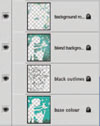
PART ONE: Getting ready to paint
1 Open up the sketch.jpg file. Starting with a sketch is an essential part of the process when painting in the tactile realm, and working in Photoshop is no exception. The main difference here is that in this case the sketch is scanned rather than being drawn directly onto the canvas. Once you’ve opened up the sketch, select the Brush tool. In the Brushes palette, enable the Smoothing option at the left. We’re going to work with this option enabled for the entire chapter because smoothing guarantees that your brush strokes contain nice, smooth curves. And that is an essential quality when you want your painting to look convincing.
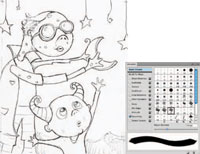
Default brushes
Although Photoshop is equipped with a plethora of excellent brush libraries, we’re going to focus on some simple default brushes capable of producing exceptional results.
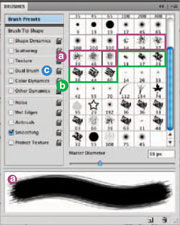
a The spatter brushes may not look like much within a vast list of presets, but these simple clusters of spots are very useful. There are a number of different tips and sizes to choose from. Regardless of which option you go with, any spatter brush gives the effect of using a brush with some stray dry bristles sticking out around the edges. Painting over the top of the colored regions of the canvas with a spatter brush allows you to create a bristled, tactile effect.
b The chalk brushes are denser than the spatter brushes but equally as useful. Strokes created with chalk brushes do not have any stray bristles sticking out the sides, but they do provide a nice rough effect at the beginning and at the ending of each stroke. They are ideal for establishing basic, yet convincing, colored regions within your painting.
c The Dual Brush option is an excellent tool that allows you to combine two different brushes within a single tip. Why do we point out this single feature amid a sea of others? Well, using the Dual Brush option allows you to quickly and easily combine two brush tips to create a new one. We’ll explore this feature in detail using custom brush tips later in the chapter.
 Project files
Project files
All of the files needed to follow along with this chapter and create the featured image are available for download on the accompanying Web site in the project files section. Visit www.creativephotoshopthebook.com.
 Saving swatches
Saving swatches
When you hit upon a combination of swatches you like, it is possible to save them for use at a later date. Simply choose the Save Swatches option from the Swatches Palette menu. This option allows you to name and then save your swatches as a library file. Save this file anywhere you like. You can always reload your saved swatches by choosing the Load Swatches option from the Swatches Palette menu and navigating to your saved preset file. If you place your library file in the presets/swatches folder within the Photoshop program folder, the library will appear within the list at the bottom of the Swatches Palette menu the next time you launch Photoshop.
2 Now, the next thing we’re going to do is establish the Swatches palette as our paint palette and fill it with our own set of colors unique to this painting. By doing this, we can return to the Swatches palette and select one of our custom colors at any point later on. Choose Edit > Preset Manager from the menu. Choose Swatches from the Preset Type menu. The Preset Manager can also be accessed via the Swatches Palette menu. If you access it via the Swatches Palette menu, the Preset Type is automatically set to Swatches. When the swatches appear, click on the first swatch and then Shift-click on the last swatch. This will target all of the swatches. When all of the swatches are targeted, click on the Delete button. After they’re all deleted, click on the Done button to exit the Preset Manager, and you’ll notice that the Swatches palette has been emptied.

3 When the Swatches palette is empty, click on the Foreground Color swatch in the toolbox to access the picker. Select a new foreground color from the picker and click OK. Move the mouse over the empty area of the Swatches palette. You’ll see it temporarily switch to a paint bucket. When you see the paint bucket, click to add the new color to the Swatches palette. Name your new swatch when prompted and then click OK. After naming, the new color is added to the Swatches palette. Use this method to add a variety of colors to the Swatches palette. This method is an excellent way to exercise a little forethought, establishing a predefined color scheme to work within before you begin painting.

4 After selecting the Brush tool, choose the largest Chalk Brush preset from the Brushes palette. In the Brush Tip Shape section of the Brushes palette, increase the diameter of the brush. You want a large brush here because, first, we want to cover most of the background with color, giving us a new base color other than white. Leave the spacing option enabled but reduce the amount to 1 so that there is no stepping or spaced brush marks present within your strokes. Choose a foreground color from the Swatches palette and click the Create a New Layer button in the Layers palette.

The background and figure outlines
5 Target your new layer in the Layers palette and begin to paint a series of strokes on the new layer. Focus on areas that are the background, as indicated in the sketch. Just start painting some strokes; don’t cover the line work of the sketch on the underlying layer; and allow a little white to show through between strokes here and there. Also, increase and decrease the brush diameter in the Brushes palette to accommodate different regions on the canvas. For open areas of the background, use a brush of very large diameter; for tighter regions, such as between the small figure’s fingers, use a brush of much smaller diameter.

 Brush angles
Brush angles
The chalk family of Brush presets is a perfect example of presets that are ideally suited to right-handed people. Generally, right-handed people paint from bottom left to top right, or from top right to bottom left. The angle of the Chalk Tip presets ensures that right-handed painters working in the typical manner get the majority of the available brush width from each stroke. If you’re left handed, try rotating the angle in the Brushes palette. You can specify any angle you like, and this angle will likely vary from preset to preset. Try starting somewhere between 37° and 45° and experiment from there. Besides rotating the angle, you can enable the Flip X option instead. This option flips the brush tip horizontally, creating a mirror image of the brush tip.
 Canvas rotation
Canvas rotation
In addition to altering the angle of the brush as you paint, Photoshop CS4 provides you with the ability to rotate the canvas. This feature helps to lend an intuitive feel to the process as you work. First, ensure that in the Performance section of the Photoshop preferences, you have enabled OpenGL drawing by checking the appropriate checkbox. Then simply select the Rotate Canvas tool from either the toolbar or the Application bar. After that, all that you need to do is click and drag on the canvas to rotate it. Also note that you can enter a numeric value for your angle or reset the view instantly in the Tool Options bar when this tool is selected.
 Locking layers
Locking layers
As your file gets bigger, it will become easier and easier to accidentally paint on the wrong layer. To prevent accidentally painting over the wrong layers, simply lock the layers that aren’t in use in the Layers palette. Choose the Lock All option just to be safe, and remember you can always go back to an old layer and edit it; you just need to unlock it first.
6 Choose a different color from either the picker or one of your own custom swatches and paint the background area at the bottom of the canvas. When you’re finished, choose a black foreground color and create a new layer in the Layers palette. Target the new layer and use the brush to begin tracing the black outlines of the underlying sketch on this new layer. Reduce the opacity of your brush in the Tool Options bar to 50% so that there is a translucent effect as you paint small strokes over the top of each other.

7 Click on the Brush Tip Shape option from the left in the Brushes palette. Use this area often to vary the angle of the brush as you paint. You’ll need to tweak the angle frequently when painting around areas such as the heads of these creatures. If you don’t adjust the angle at times, there will be areas where the strokes appear too thin compared to others. Click on Shape Dynamics in the Brushes palette to enable Shape Dynamics and then on the Angle Jitter Control menu to view the options.
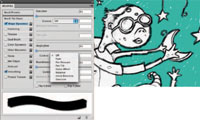
8 Choose the Direction option from the Control menu, but leave the angle jitter amount set to 0. This setting causes your brush to base the angle of the brush tip on the directions of your stroke as you paint them. Because we still want a somewhat smooth edge to the strokes, the amount is set to 0. The more you increase the amount, the rougher the edges of the strokes will appear. By simply enabling the Shape Dynamic function, you can save yourself the trouble of having to constantly adjust the angle as you paint. Finish painting the black outline.
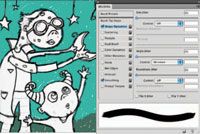
9 Reduce the opacity of your brush to 25% and then open the Tool Preset picker at the far left of the Tool Options bar. Click on the Create New Tool Preset button. When you are prompted, name the tool “Chalk Blender.” Disable the Include Color option and click OK. This brush is now added to the preset picker, with all of the Brushes palette options and dynamic functions intact. You can access it directly from the preset picker from now on. Create a new layer in the Layers palette and ensure that it is targeted.
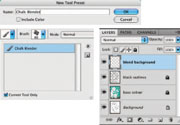
 Current tool only
Current tool only
In the Tool Preset picker, you will see an option for the current tool only. Enable this option for the duration of this chapter. Enabling this option will show only presets for the Brush tool rather than the saved presets for all of Photoshop’s tools. Because we’re only using the Brush tool from here on in, there is no need to view other tool presets.
 Canvas rotation shortcuts
Canvas rotation shortcuts
You can quickly access the Canvas Rotation tool by pressing the “r” key. After rotating, press the “esc” key to return the canvas rotation to its original state. Also, you can simply hold down the “r” key while you’re painting, which will allow you to temporarily access the Canvas Rotation tool. You can click and drag to rotate and then, when finished, release the “r” key to return to the Brush tool.
 Brush presets versus tool presets
Brush presets versus tool presets
When you save one of your current brushes as a tool preset, not only are all of your Brushes palette options saved within the preset, but all of your Tool Options bar items are also included. If you wish to save a Brush preset without the Tool Options bar items being included, do so via the Brushes palette menu. Choose New Brush preset from the Brushes Palette menu to save your current brush, adding it to the list of presets in the Brushes palette, independent of the Tool Options bar items.
 Using a stylus
Using a stylus
You can indeed paint with a mouse, but it can be a laborious task at times. It is certainly not the most intuitive way to paint. If you plan on doing much painting in Photoshop, it is definitely worth investing in a pressure-sensitive tablet and a stylus. Drawing with a pen is much more intuitive and easier than drawing with a mouse. Also, there are a number of dynamic brush functions that work with pressure sensitivity, tip angle, and stylus rotation. So yes, you can complete this chapter and learn about painting by using a mouse. But if you really want control when you paint, a stylus is a worthwhile investment.
10 Use your current brush, set to 25% opacity, to blend the background fill colors together on the new layer; this is precisely why we named the preset “Chalk Blender.” Start by painting strokes over the areas where light and dark colors meet. Paint dark strokes over light areas, and vice versa. Go back and forth painting like this until colors begin to blend together. Change the direction of your brush strokes often as well as the size of your brush tip. Also, if using an opacity of 25% does not give you a blend effect that is as smooth as you’d like, try reducing it when necessary.
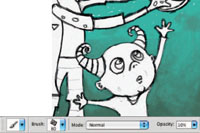
11 Now add different colors from the Swatches palette into the background here and there, using the same brush on the current layer. Try initially adding them using a higher brush opacity setting, and then blending them into the background using lower opacity settings. A quick way to work is to Alt(PC)/Option(Mac)-click on areas of the canvas to sample color rather than always returning to the Swatches palette. This technique is especially useful when blending as you can sample “in-between” colors. Using this method, if you happen to sample a foreground color that you like, feel free to add it to the Swatches palette so that you can access it later.

12 In the Brush presets section of the Brushes palette, select the spatter 59 pixels Brush Tip preset. Now, in the Brush Tip Shape section of the Brushes palette, adjust the angle of the brush tip until you’ve achieved the roughest looking stroke possible. In the Tool Options bar, set the opacity of the brush to 35% and the flow value to 15%. Save this new brush as a tool preset and name it Spatter Rough.

13 Create a new layer and use your newly created tool preset to paint over areas of the canvas on this layer. Increase or decrease the opacity as required and use colors from the canvas or the Swatches palette. The goal here is to paint with the new brush over areas that look very smooth. Because of the brush tip and very low flow setting, the resulting strokes will add a rougher, more textured feeling to the areas you paint. Using large brush strokes and bold colors will pronounce the rough effect. Use this effect sparingly as it can tend to overpower an illustration.
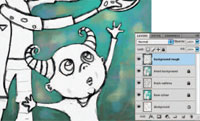
 Flow
Flow
While opacity controls how transparent or solid your strokes will appear on your layer, it is the flow setting that controls how much paint is deposited within a brush stroke as you paint. Reducing the flow drastically, as we’ve done here, will make the brush stroke look dryer because less paint is deposited. Increasing the flow will cause the bristles that make up the brush stroke to be less pronounced, as the stroke is heavier with paint and the space between the bristles will fill in.
14 Open up the brush1.jpg file. Choose Edit>Define Brush preset from the menu. Name your brush and return to the working file. Choose your new custom brush tip from the end of the list in the Brush Presets section of the Brushes palette. In the Brush Tip Shape section of the Brushes palette, set the spacing to 1. In the Tool Options bar, set the opacity to 50% and the flow to 15%. Save this brush as a new tool preset. Use this same method to open up brush2.jpg and brush3.jpg and save them as new tool presets, using the same spacing, opacity, and flow settings.
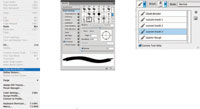
Dual brushes
Now we’ll explore the Dual Brush function in the Brushes palette, creating entirely new brushes from combinations of custom brush tips.
1 Choose your first custom brush from the Tool Preset picker. Then, in the Brushes palette, click on the Dual Brush label at the left side of the palette to enable the Dual Brush function and access the settings.
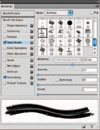
2 Choose your second custom brush tip from the Tool Preset picker. Enable the Random Brush Flip option at the upper right corner and set the mode to multiply. Increase the spacing to about 20%; you’ll notice that it looks like a chalk pastel stroke in the preview.

3 Leave the opacity and flow at their current settings in the Tool Options bar and then add this new dual brush to the Tool Preset picker. Because it looks like a chalk pastel, go ahead and name it something appropriate.

15 Now that you have added three new custom brushes and a new dual brush to the Tool Preset picker, use them to paint some rough strokes on this layer. Just because the presets contain embedded settings for opacity and flow, that doesn’t mean that you can’t change them each time you use them. Use a variety of colors, brush sizes, opacity, and flow settings to introduce some very real and tactile feeling brush strokes on the current layer. Again, ensure that you do not overdo it as these new brushes, which produce such distinct strokes, can visually overpower the softly blended background quite easily.
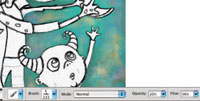
 Defining brushes
Defining brushes
When we created custom brushes from images previously, the images were black and white only. However, you can use a color or grayscale image as well. The advantage to using black and white is that you can get a good idea of how your resulting stroke will look from the image used to define the brush. Black areas will deposit paint and white areas will not. A grayscale brush tip will deposit paint according to the density of black it contains. Color images are converted to grayscale when you define brush tips from them.
16 When you’re finished, target the top layer and then Shift-click on the layer directly above the background layer in the Layers palette. This will target all of your paint layers. Choose Layer >New>Group From Layers from the menu to add them to a group. Because we’re going to start painting the other image components, this grouping of layers will help us keep things separate and organized. Create a new layer for the base color of the figures. In the Brushes palette, choose one of the default chalk brush tip presets. Ensure that Smoothing is enabled, and in the Brush Tip Shape section of the palette, reduce the spacing amount to 1.

PART THREE: Painting the figures
17 In the Tool Options bar, set the opacity of the brush to 100% and the flow to 50%. Add this brush to the Tool Preset picker and name it “base color,” as we’ll be using it to create a flat, colored base for the figures and the stars. Use this brush to add flat color on the new layer in all empty regions of the figures and the stars. Choose colors from the background via the Eyedropper or select them from the Swatches palette. Increase or decrease the size of the brush tip as necessary.

 Brush size
Brush size
When you have a brush selected, a quick way to increase or decrease the brush size incrementally is to use the square bracket keys on the keyboard. Press the “]” key to increase the diameter, or press the “[” key to decrease the diameter. This method is great for adjusting size on the fly.
 Importing brushes
Importing brushes
The brushes used to create this chapter’s painting are in the same archive as the rest of the project files. You can load the brushes by choosing the Load Tool Presets option from the Tool Preset picker’s Palette menu. Navigate to the aforementioned file and these brushes will become available in the Tool preset picker.
18 Create a new layer and select the Chalk Blender preset that you created earlier from the Tool Preset picker. As you did earlier with the background, blend the colors beneath this layer together with the Chalk Blender preset on your new layer. Hold down Alt(PC)/Option(Mac) to quickly sample colors from the canvas and then paint with your newly sampled colors in the appropriate areas until sharp areas of color begin to blend together on this layer. Feel free to alter brush size and opacity as required. Also, feel free to add new areas of color on this layer to indicate highlights and shadows.
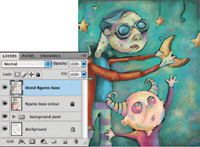
19 When you are finished adding colors and creating a blending effect on this layer, create a new layer and target it in the Layers palette. Select your Spatter Brush preset from the Tool Preset picker. Now use the spatter brush to paint some light, yet rougher brush strokes over your recently blended areas on the new layer. Use colors sampled from the canvas or from the ever-growing amount of custom swatches in the Swatches palette. Vary the brush size and opacity as needed. You probably want to leave the flow setting fairly low so that the bristles remain pronounced in each stroke.
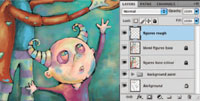
 Brush opacity
Brush opacity
When you are working with the Brush tool, a quick way to alter the brush opacity is to simply use the number keys on the keyboard as you paint. Just type the opacity value you’re after, and it will automatically change in the Tool Options bar.
20 Now use your three custom brushes as well as your dual brush to really add a sense of roughness to the figures and the stars by painting with them on the current layer. Vary size, color, and opacity as needed. Also, if you feel like experimenting, yet are worried about making a mistake on your current layer, go ahead and create another layer to work on. This way, if you like the effect, you can keep the layer. If you don’t like it, you can always delete the layer or even reduce the opacity to lessen the effect.
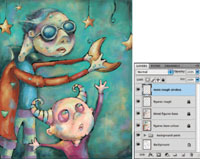
PART FOUR: Realistic canvas texture
21 Now, the painting techniques that you’ve used so far are certainly successful in creating a realistic painterly effect. However, when painting digitally, no matter how convincing your brush strokes are, it is the smooth and perfect surface that ruins the authenticity you’ve tried so hard to achieve. In order to remedy this, it is often helpful to involve something genuine. Open up the painting.jpg file. This file is a desktop scan, in grayscale, of a section of an oil-painted canvas. We’re going to add this to our painted file to make use of the canvas texture and the cracked paint effect.
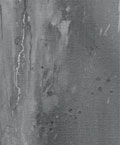
 Saving tool presets
Saving tool presets
To save all of the tool presets that you’ve created from existing brushes as well as custom brushes you’ve defined from image files, launch the Preset Manager. Choose Tools from the Preset Type menu and click on one of your own brush tools. Hold down the Shift key and click on the remaining brush tools you created. When they are all selected, click on the Save Set button to save them as a separate file on your hard drive. Loading the preset file later on is as simple as clicking the Load button and navigating to your saved preset file.
22 Use the Move tool to click on the painting.jpg canvas and drag it into your working file as a new layer while holding down the Shift key. Holding down the Shift key ensures that it lands in your file in the proper position. Ensure that the new grayscale paint layer is at the top of the Layers palette and change the blending mode of the layer to color burn. Reduce the opacity of the layer to 14%, and you’ll see that a surface texture effect is beginning to take shape as the colors on the underlying layers become darker and more saturated.
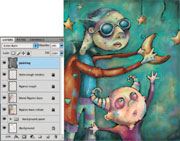
23 Now duplicate your painting layer by dragging it onto the Create a New Layer button at the bottom of the Layers palette. Change the blending mode of your duplicate layer to vivid light and increase the opacity to 35%. Finally, duplicate your current painting copy layer and then change the blending mode of the recently duplicated layer to soft light to intensify the surface texture effect within the image.
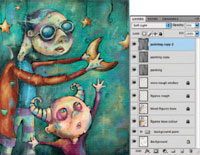
Examining your technique
Now that you’re finished, let’s take a closer look at some of the things that make this the ideal process for painting digitally.
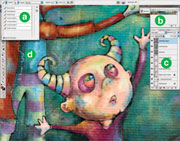
a When you customize your own brushes, and especially when you create your own brush tips from images, saving your tool presets is a very good idea because it ensures that they are always available to you. And saving them as a preset library file ensures that you can access them at any point later on, within this or any other Photoshop file.
b Building up your own custom swatches in the Swatches palette is the digital equivalent of a handheld painter’s palette. Your colors will always be available to you here. Choose the Save Swatches option from the Swatches Palette menu to save them as a file on your hard drive. You can load them or replace an existing set of swatches by choosing either option from the Swatches Palette menu and navigating to your saved file. Swatches can also be saved or loaded in the Preset Manager.
c Keeping different elements and different stages in the process separated on a series of layers allows you enough flexibility to revisit things later and alter them. You can target individual layers and edit or mask their contents. Also, you can insert adjustment layers between layers to affect only certain portions of the composition.
d Using a real-world surface texture is an excellent way to add another level of authenticity to your painting. The simple grayscale scan used here on a series of layers helps to remedy the ultrasmooth digital canvas surface, making it more realistic in the end.
A more realistic approach
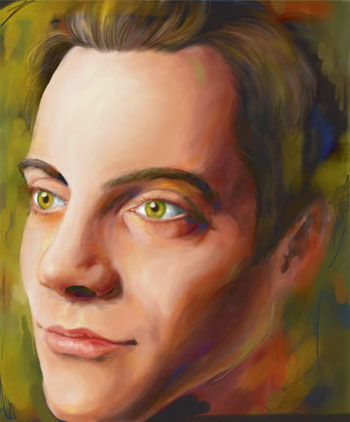
This method of painting is certainly not limited to the subject matter or rough style that was covered previously in this chapter. You can apply this method to the subject of your choice and paint in any style that comes naturally. Here I decided to give traditional portraiture a try. Rather than starting with a sketch, I placed a photograph on an underlying layer and used it as a guide while I was working. Unlike the sketch, it proved to be too distracting if it was visible the entire time. So I simply enabled the visibility of the photo periodically to stay on track. Another thing to consider when you’re after a more realistic approach is the fact that you’ll need to spend a lot more time blending colors together to make smooth, seamless transitions.
Virtual life drawing
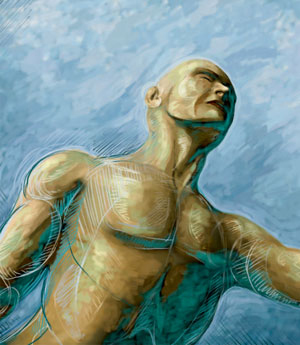
Rather than sitting in a studio with charcoal, paper, and an actual model, why not replicate the process on your laptop or PC? I launched Poser and rendered a male figure using the pose shown here and a couple of colored lights. I then rendered the file and opened it in Photoshop. This acted as my base layer. Then, I employed the techniques explained on the previous pages across a series of layers to create this impressionistic figure painting.
